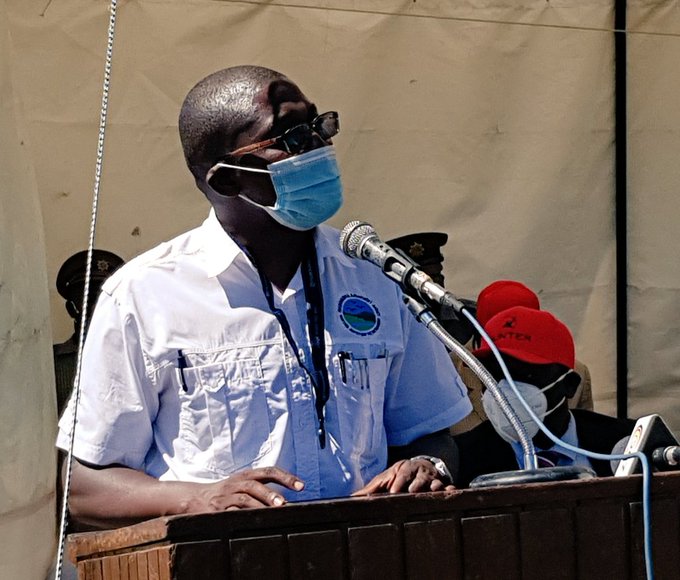|
Getting your Trinity Audio player ready...
|
Stakeholders have been urged to prevent veld fires whose impacts are multifaceted and a threat to the biophysical, social and economic environment because of their trail of destruction that cuts across all sectors of the economy.
Wildfires constitute 10% of the world’s emissions and nearly half of this is related to Southern Africa. In Southern Africa alone, approximately 170 million hectares of forests and grasslands are burnt each year. Zimbabwe is not spared from the challenge, burning an average of 1.5 million hectares and in the process producing over 30 million tonnes of carbon emissions which is about 7% of the country’s emissions per year.
Today, Honourable Mangaliso Ndlovu, the Minister of Environment, Climate, Tourism and Hospitality Industry launched the National Fire Week at Gwebi Agricultural College in the Zvimba District of Mashonaland West Province whereupon he revealed that the second week of May is set aside for education and awareness-raising on the dangers associated with veld fires and therein strategies for their prevention.
Statutorily, the veld fire season in Zimbabwe stretches from 31 July to 31 October each year. According to Minister Ndlovu, what this basically means is that the veld fire season ends when the country receives the first effective rains to break the fire triangle, but the period has not differed significantly in reality despite the effects of climate change.
According to the National Fire Management Strategy and Implementation Plan of 2006, the National Fire Week Launch is meant to raise awareness amongst communities on the need to prevent veld fires by undertaking pre-fire suppression measures such as fireguard construction, biomass reduction and early controlled burning.
The theme for this year’s national fire week commemorations is “Veld Fires and Food Security- Protect the harvest”, a theme with a focus towards revealing the nexus between veld fire management and sustaining food security.
“The country’s agricultural yield projection for the 2020/21 season indicates a bumper harvest, one of its kind in 37 years, which we should all celebrate and judiciously protect. As we all celebrate the projection of a good national crop yield, we should, however, be cognisant of the environmental factors which dominate our landscapes and it is not yet time to relax. We should therefore all work together to prevent catastrophic losses to our harvest from veld fires.
“Veld fires have become an issue of National concern given their wanton destructive nature. Each year, the country loses over a million hectares of forests and grasslands depriving wildlife and livestock of pastures and leaving the country counting losses of property, crops and life,” Minister Ndlovu said.
Minister Ndlovu shared statistics about the impact of veld fires. The annual average burnt area from 2010 – 2020 was 1 million hectares. An average of 60% of the total burnt area has been under the A1 and A2 resettlement areas. The minister said of the 18,000 A2 farmers, only about 400 have 99-year leases, which leases have specific clauses on environmental protection. This creates a possibility of a massive information gap on the responsibilities of farmers in their properties.
The ministry of environment has begun a comprehensive awareness programme with the Ministry of Lands, Agriculture, Fisheries, Water and Rural Resettlement through their Agritex extension services where every farmer is expected to construct their fireguard in compliance with the laws of the country.
Minister Ndlovu bemoaned the fact that over the past 10 years, veld fires have led to over 100 fire-related deaths. He said that it is too big a figure to ignore and that no life should be lost to veld fires because one life lost is one too many. This is underpinned by the fact that life is precious and hence the need to thrive as a country to prevent loss of life.
The African Youth Initiative on Climate Change (AYICCZIM), in partnership with FireFight, is organising a Biomass Reduction Event along the Arcturus Road on 14 May 2021 as part of commemorating the National Fire Week.
Mr Jean-betrand Mhandu, the AYICCZIM National Coordinator revealed that over the last couple of years, urban cities have experienced untold veld fires due to the amount of existing biomass from urban agriculture and the grown foliage.
“Studies show that there is generally a lack of awareness on fires and what drives them, therefore it is imperative that more efforts are made in raising earnest awareness to urbanites on the causes, dangers and demonstrating how they can reduce the risks of veld fires.
“We propose to reduce the lingering biomass along the servitudes of one of Harare’s busiest roads. Arcturus Road between Harare Drive and Lafarge Cement plant has become an environmental and traffic hazard with tall thick grass obstructing motorists, with the potential of catching fire spontaneously leading to uncontrolled fires. In a stakeholder effort, we hope to partner with organizations operating along the stretch of the road and communities living in the said area, to cut and clear the tall grass and clean the servitudes for the general health of the public. This deliberate effort will help reduce roadside fires which have become a common feature in the urban and identified areas,” Mr Mhandu said.
Impacts of veld fires range from loss of livelihoods and income, psychosocial impacts associated with fatalities and family bereavement, loss of biodiversity and disturbance of the hydrological balance. The dry and warm winters, experienced over Zimbabwe, combined with abundant grass fuels and ready sources of ignition (both lightning and humans) ensure that fires are a regular feature of savanna landscapes. Besides the loss of biodiversity and economic losses, veld fires also reduce the aesthetic value of the land.






